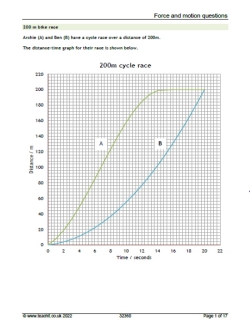Force and motion questions

A comprehensive set of KS3 force and motion questions for students to complete to consolidate learning, for homework or for a formative assessment.
Students consider a range of scenarios (a bike race, a space rover on mars, a remote-controlled car's speed, a helium-filled balloon's speed etc.) before completing a range of questions, using line graphs to complete their answers. It's ideal for developing maths skills in science and includes answers for self or peer marking in class.
With line graphs and questions covering speed, distance and time, friction, mass and pressure, there are over fifty questions, broken down into different topics, so you can easily choose the most appropriate questions for your students.
Example questions from the resource:
Use the information on the graph to answer the following questions.
- Describe the motion of the remote-controlled car between:
- 0 seconds and 4 seconds. ..........................................................
- 5 seconds and 9 seconds. ..........................................................
- 16 seconds and 18 seconds. ..........................................................
- Calculate the average speed of the car between 0 and 18 seconds. Give the unit. ..........................................................
- When the car was travelling at a constant speed the forward force of the motor was equal to the backward force of friction.
Describe how the forward force from the motor and the backward force of friction compare during:
- The first four seconds. ..........................................................
- Between 5 and 9 seconds. ..........................................................
- The last two seconds. ..........................................................
- Use the graph to find the time taken for the car to travel between 6 metres and 16 metres.
- Calculate the speed of the car between 6 and 16 metres. ..........................................................
- In a second journey, Ahmed and Beth timed the remote-controlled car over a distance of 20 metres again:
- For the first 10 metres the car travelled uphill at a constant speed of 1.4 m/s
- For the second 10 metres the car travelled downhill at a constant speed of 2.5 m/s
Represent the second journey on the graph.
